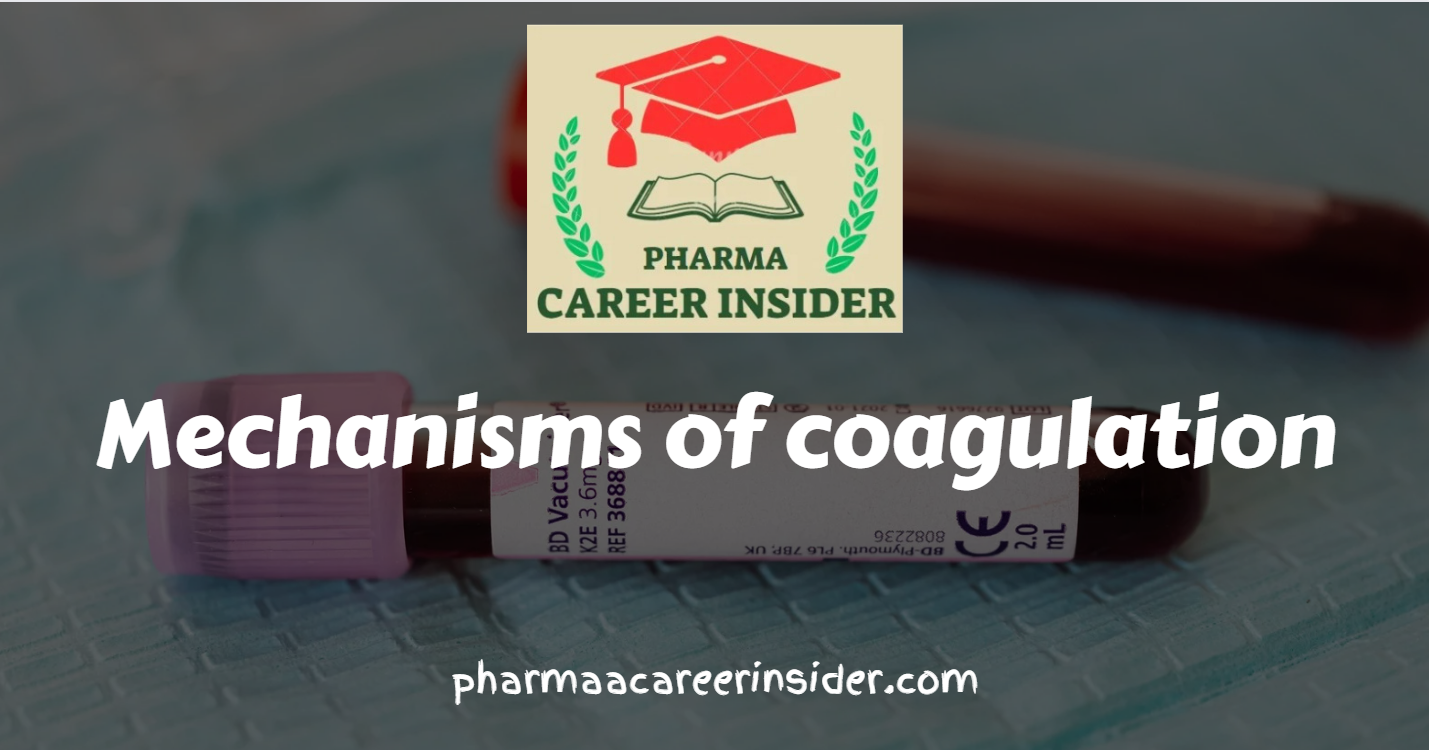Blood coagulation, or clotting, is a complex and tightly regulated physiological mechanism that prevents excessive bleeding following vascular injury. It involves a series of sequential and interrelated reactions that ultimately lead to the formation of a blood clot. The coagulation process can be divided into three main pathways: intrinsic, extrinsic, and common. Here’s a detailed note on the mechanisms of coagulation:
1. Intrinsic Pathway:
– The intrinsic pathway, known as the contact activation pathway, is initiated within the bloodstream. It typically begins when blood comes into contact with foreign surfaces, such as collagen, exposed by vessel damage.
– The key players in the intrinsic pathway are clotting factors present in the blood, including:
1: Factor XII (Hageman factor)
2: Factor XI (Pta)
3: Factor IX (Christmas factor)
4: Factor VIII (Antihemophilic factor)
The intrinsic pathway proceeds as follows:
a. Factor XII is activated by contact with exposed collagen or other activators.
b. Activated factor XII activates factor XI in the presence of prekallikrein and high-molecular-weight kininogen.
c. Activated factor XI then activates factor IX.
d. Factor IX, in the presence of factor VIII, forms a complex that activates factor X.
2. Extrinsic Pathway:
When tissue damage occurs and tissue factor (TF), also known as factor III, is exposed, it initiates the extrinsic pathway outside the bloodstream.
– The extrinsic pathway plays a crucial role in initiating coagulation rapidly in response to vascular injury.
The main components of the extrinsic pathway are:
– Tissue factor (TF)
– Factor VII (Proconvertin)
The extrinsic pathway proceeds as follows:
a. Tissue factor (TF) is released from injured tissues.
b. TF combines with activated factor VII to form the extrinsic tenase complex.
c. The extrinsic tenase complex then activates factor X.
3. Common Pathway:
– The intrinsic and extrinsic pathways converge to form the common pathway, ultimately forming a stable blood clot.
– The common pathway involves several key clotting factors, including:
1: Factor X (Stuart-Prower factor)
2: Factor V (Labile factor)
3: Factor II (Prothrombin)
4: Factor I (Fibrinogen)
The common pathway proceeds as follows:
a. Factor X combines with factor V to form the prothrombinase complex.
b. The prothrombinase complex converts prothrombin (Factor II) into thrombin (Factor IIa), a critical enzyme in coagulation.
c. Thrombin plays a central role by catalyzing the conversion of soluble fibrinogen into insoluble fibrin strands.
d. Fibrin strands form a mesh that traps blood cells, creating a stable blood clot.
4. Fibrinolysis:
– Once the blood clot has served its purpose, the body initiates fibrinolysis, a process to dissolve the clot.
The enzyme plasmin is responsible for breaking down fibrin into soluble fragments.
Tissue plasminogen activator (tPA) and other activators actively form plasmin from its precursor, plasminogen.
Fibrinolysis helps to restore normal blood flow once the injury is healed.
Disruptions or imbalances in the coagulation cascade can actively lead to bleeding disorders or thrombotic conditions, as it is a finely tuned process. Various regulatory mechanisms, such as anticoagulants and fibrinolytic factors, exist to prevent excessive clot formation and maintain a balance between clotting and bleeding.
Steps involved in coagulation of blood
The coagulation of blood involves a sequence of steps to actively form a stable blood clot when a blood vessel is injured.
1. Vasoconstriction (Vascular Phase):
When a blood vessel is injured, it constricts or narrows to reduce blood flow to the injury site. This is the initial response to minimize blood loss.
2. Formation of the Platelet Plug (Primary Hemostasis):
Platelets, small cell fragments in the blood, play a vital role in coagulation.
When blood vessels are damaged, collagen and other substances are exposed at the injury site. Platelets adhere to these exposed surfaces.
Platelets become activated, changing shape and releasing chemical signals to attract more platelets to the site.
A platelet plug is formed, temporarily sealing the damaged blood vessel.
3. Coagulation Cascade (Secondary Hemostasis):
The coagulation cascade is a sequence of enzymatic reactions that ultimately lead to a stable blood clot formation.
It involves two main pathways, the intrinsic and extrinsic ones, converging into the common pathway.
Clotting factors in the blood, including factors II (prothrombin), V, VII, VIII, IX, X, and XIII, play key roles in this process.
The cascade leads to converting soluble fibrinogen into insoluble fibrin threads, creating a mesh that traps blood cells and forms the clot.
4. Clot Retraction:
– After the fibrin mesh has formed, the clot retracts or shrinks, pulling the edges of the damaged blood vessel together.
– This helps to reduce the size of the wound and further control bleeding.
5. Fibrinolysis:
– Once the injured blood vessel has healed, the body initiates fibrinolysis, breaking down the blood clot.
– Plasmin, an enzyme, is responsible for the breakdown of fibrin into soluble fragments.
– This process ensures that normal blood flow is restored.
6. Clot Consolidation and Repair:
While the clot is broken down through fibrinolysis, the body begins to repair and regenerate the damaged tissue.
New blood vessels and connective tissue are formed to restore the blood vessel’s integrity.
Any imbalance in these steps in the coagulation process can actively lead to bleeding disorders (hemorrhagic) or clotting disorders (thrombotic). The body actively employs various mechanisms and regulatory factors, including anticoagulants and fibrinolytic enzymes, to balance clotting and bleeding. Coagulation plays a critical role in preventing excessive blood loss while ensuring normal blood circulation once the injury is healed.

